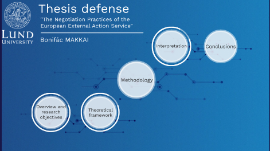Thesis defense - Lund University
Transcript: "The Negotiation Practices of the European External Action Service" Thesis defense Bonifác MAKKAI Overview Overview and research objectives Topic Topic - Practice theory - Two-level game theory Theories Theories Q1: How can we describe the practices of EEAS in the negotiation of the EU-Cuba Political Dialogue and Cooperation Agreement? Research questions Research questions Q2: What conclusions can be drawn on EU international negotiations? Q3: What is the added value of practice theory in the study of international negotiations? Theoretical objective is of primary importance! Objectives Objectives EU - Cuba Political Dialogue and Cooperation Agreement (PDCA) Case study Case study Theoretical framework Theoretical framework Practice theory Practice theory Definition Practical intelligibility Patterned and processive Discursive Social recognition and relevance Contextual Core concepts Two-level game theory Two-level game theory o Level I and Level II distinction o Linked by the concept of ratification o Concept of win-set o Determinants of win-sets (Level I strategies, Level II institutions, Level II preferences) o Basic assumptions: larger the win-sets more likely the agreement the smaller the win-set the bigger negotiating advantage gain maximization at level I interest differences between chief negotiator and constituencies win-sets are rigid, based on rational calculations two phases: negotiation and ratification Practice theory can synergize well with two-level games to produce unique results for EU international negotiation research. Hypothesis Hypothesis Methodological framework Methodology Method and case selection 3rd step: generalization 2nd step: interpretation 1st step: data gathering PDCA negotiations and interpretation Interpretation PDCA negotiations PDCA negotiations Level II processes (EEAS coordination role, manipulation at COLAC, activities of associated DGs, EP ratification and civil group influence) Background (Common Position + pre-negotiations – convince MSs to come onboard) PDCA: political dialogue, cooperation and sector-policy dialogue, trade cooperation Level I negotiations (EEAS role and its activities, trust and slow pace, Cuban familiarity with EU processes, Cuban demands, EU demands, EEAS strategies, human rights dialogue) Locating practices Locating practices Interpretation through two-level game theory Interpretation through two-level game theory ratification is a process, commitment, predictability, defection, high autonomy (Cuba) does not automatically transfer to higher win-set interrelation between levels through practices (rather than ratification), limits of levels and phases (exclusion of pre-negotiations e.g.) politically salient issues involve tough negotiations and vice-versa, role of asymmetry, trust-building is important! fluctuation of preferences (limited by negotiating directives), win-set fluctuation, multiplicity Expository levels Level I strategies Level II preferences Level II institutions Conclusions Conclusions Q 1 Q 1 EEAS practices crucial during negotiations. Possessed authority and capability. How can we describe the practices of EEAS in the negotiation of the PDCA? Q 2 Q 2 EU is a tough negotiating partner, but not as rigid as one may think. What conclusions can be drawn on EU international negotiations? Q 3 Q 3 What is the added value of practice theory in the study of international negotiations? I argue that the utilization of practice theory promises valuable cross-avenues for the interpretation of the two-level game model. Parties will seek gain maximization at Level I: practice approach proves that this might not always be the case, practical intelligibility is key here. Two-level game theory assumptions Asymmetric win-set sizes provide negotiating advantage at Level I: partially true. In issues of high political sensitivity (or social relevance and recognition) parties will seek more distributive tactics. Vice-versa. The larger the win-set sizes of the parties, the more likely that agreement may be found. Not specifically tested, but PDCA negotiations may underscore this assumptions. Two-level game assumption that groups with special interests/preferences will have more influence is underscored. Nature of win-set sizes Theoretical conclusions Phases and pre-negotiations Expository levels Level II institutions and win-sets Measuring effectiveness of practices Practices as links between levels Main challenges Main challenges Word Count Technical corrections Theoretical challenges Methodological challenges Equifinality

















